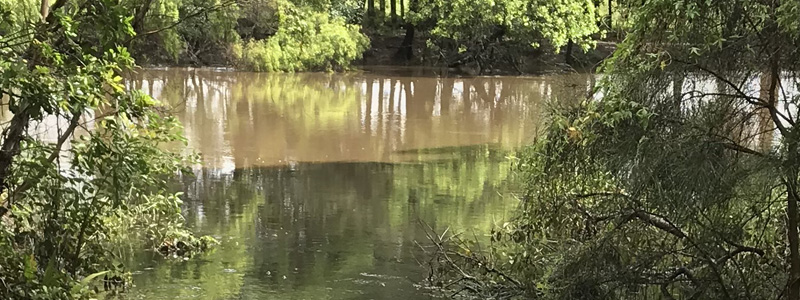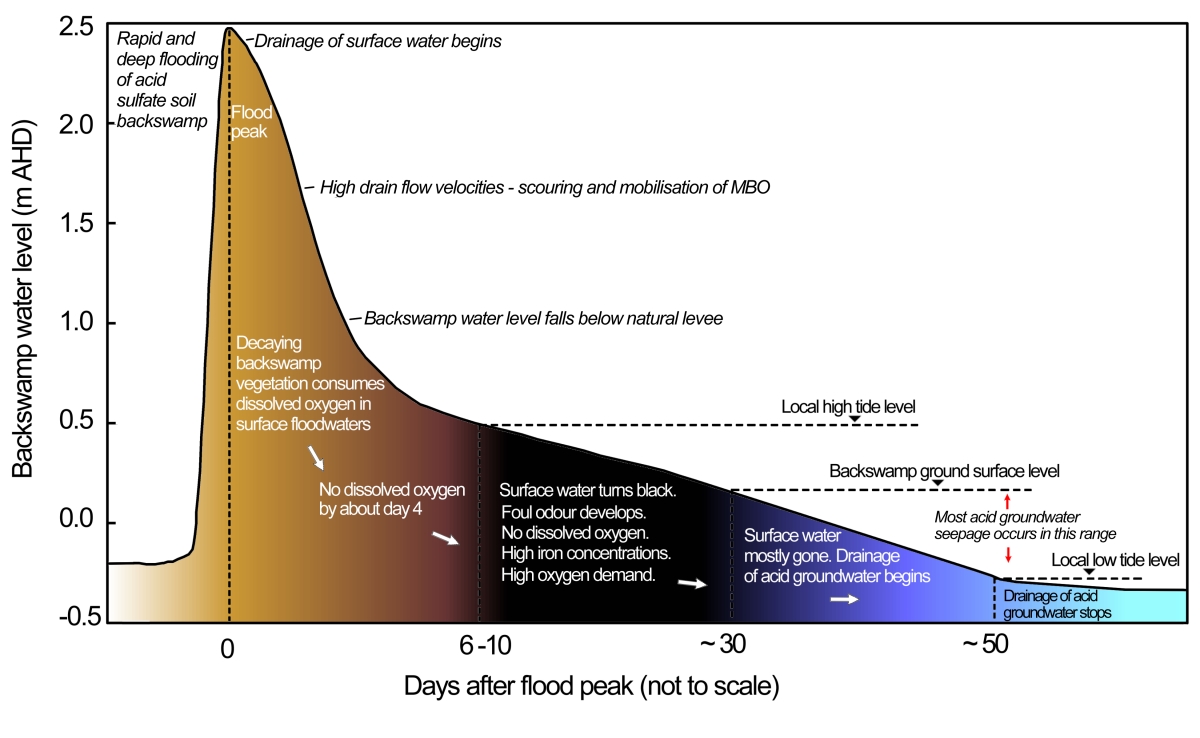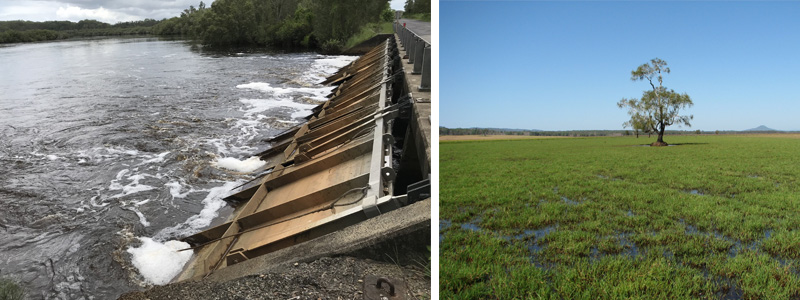
Home » Flood mitigation » Floodplain management » Understanding blackwater: Technical note
In This Section
Understanding Blackwater in the Richmond River Estuary
Technical Note

Blackwater:
What is it, what causes it,
what can be done about it?
This technical note summarises current scientific knowledge of blackwater and results from the recent collaborative Australian Research Council project ‘Episodic estuarine hypoxia: resolving the geochemistry of coastal floodplain blackwaters’, which focussed on the Richmond River floodplain and was led by Professor Leigh Sullivan.
The intention of this technical note is to provide a common, plain-English understanding of blackwater to guide management at a local government, state agency, industry and landowner level. It was compiled by Chrisy Clay (Rous County Council) and Suzanne Acret (Ballina Shire Council) with the input and endorsement of Professor Leigh Sullivan (University of Canberra), Professor Scott Johnston (Southern Cross University) and Dr Vanessa Wong (Monash University).
Rous County Council and Ballina Shire Council have an active interest in water quality issues associated with flood mitigation infrastructure. In developing this technical note, both councils seek to raise awareness and interest of blackwater and provide an up to date understanding of the issue and the complexity in addressing it.
Clay C., Acret S., Sullivan L. (2020) Blackwater: what is it, what causes it, what can be done about it? Technical Note. Rous County Council and Ballina Shire Council. Click here to download a copy (2.4mb).
 |
| Blackwater mixing with brown floodwater in Bungawalbyn Creek. |
Frequenty asked questions
What is blackwater?
- On the Richmond floodplain, blackwater is usually dark in colour (due to the breakdown of plants and other organic matter) and contains little or no oxygen.
- The organic matter in blackwater can consume large amounts of dissolved oxygen, and if mixed into rivers and creeks can deoxygenate waterways.
- Blackwater has a very unpleasant smell.
How is blackwater formed?
On the Richmond floodplain, blackwater forms from the rapid biological breakdown of plant material in water. This is part of the natural carbon cycling process.
However, drainage of the floodplain has affected the formation of blackwater in several ways. Floodplain drainage includes the construction of artificial channels and levees, straightening of natural waterways and installation of floodgates.
- Floodplain drainage has encouraged flood intolerant plant/pasture species to establish in low-lying areas. These species are more likely to die and decompose when inundated after flooding.
- Floodplain drainage has both accelerated and prolonged the transport of blackwater to the river, particularly when flood levels recede and the river’s capacity to dilute this water is reduced.
- Blackwater events are more common and severe in the warmer months because of the amount of flood intolerant grass pasture present on the floodplain, higher air temperatures that increase biological breakdown of flooded grasses, more intense sunlight and the likelihood of heavy rain and floods. Predicted future warming associated with climate change is likely to increase the frequency of blackwater events.
 |
| Graph: General water quality processes after flooding. (Johnson, S. et al 2003.) |
Is it acidic? Or influenced by acid sulfate soils?
Blackwater may form in acid sulfate soil environments (i.e. low-lying areas on the floodplain), but the chemistry of acidic discharge and blackwater is usually different. Both issues may impact a particular waterbody (such as a creek or a drain), but they form from different processes.
What are the impacts of blackwater?
- Fish and other aquatic animals need dissolved oxygen in the water, so blackwater is harmful. Severe blackwater events cause mass fish kills. Large fish kill events in the Richmond River have occurred repeatedly as a result (e.g. 2001 and 2008).
- Large volumes of blackwater can form across the floodplain after major floods. When blackwater enters the river, the river’s capacity to absorb blackwater is exceeded and there can be major fish kills.
- Major fish kills impact the surrounding community’s economy and significantly affect the estuary’s health and resilience. In 2001, the Richmond River was closed to all fishing for six months, and in 2008 it was closed for a month.
- Less severe blackwater events can cause fish to be more susceptible to disease, kill smaller and more sensitive animals that some fish feed on and interrupt breeding cycles.
 |
| Dead fish at Ballina after flooding in 2008. |
How can the formation of blackwater be minimised?
- Floodplain drainage accelerates and prolongs the transport of blackwater from low lying floodplain areas, after the flood peak when flood levels recede. The lowest lying areas, which were former backswamp wetlands, previously stored floodwaters and were inundated for long periods. Floodplain drainage now removes most of the surface water in about 4-28 days after the flood peak.
- Blackwater formation can be minimised by reducing drainage density, particularly in low-lying areas of the floodplain. This can occur by filling in unneeded drains or reshaping drains, so they are less deep and more shallow and wide. This will slow drainage rates and retain surface flood waters for longer periods in the lowest lying areas.
- Reducing drainage density will also encourage native wet-tolerant plant/pasture species in low-lying areas that are more tolerant of flooding.
- Significant improvements could be made to lessen the severity of blackwater events if the lowest lying floodplain areas were kept wetter, grew wet-tolerant vegetation and the worst-water-quality water could be held back during the flood recession.
- As a general rule, blackwater retained on floodplains for four to eight weeks or more after inundation, will lose most of its capacity to cause deoxygenation of river waters even though it retains the black colour.
- These changes would significantly affect the management and use of floodplain areas, particularly for agricultural use.
 |
| Deep inundation of the floodplain during 2008 major flood. |
Where are the priority areas for management in the Richmond?
- Low lying floodplain areas associated with the Tuckean, Rocky Mouth Creek and Bungawalbyn/Sandy Creek, vegetated by flood intolerant plants/pastures such as Paspalum, Setaria and Carpet Grass or Compressum (Axonopus compressus). The majority of blackwater, in a major event, comes from these three areas. In the first instance, these would be the priority locations for reducing drainage density and as a result, changing the vegetation growing there.
- However, in a major flood, higher areas of the floodplain can also form blackwater. All sources of blackwater contribute to exceeding the river’s capacity to absorb blackwater.
Can we stop blackwater events from ever happening again?
The geomorphic features of the Richmond River catchment make it particularly vulnerable to deoxygenation or blackwater events. In terms of catchment to floodplain ratio, it has the largest coastal floodplain in NSW relative to its catchment size. The run off from such a large floodplain, particularly following summer flooding, into a relatively small receiving water of the Richmond River estuary can deoxygenate extensive stretches for prolonged periods of time. In comparison, the Clarence River is the reverse, with an extensive catchment and a large river, and a less mature and smaller floodplain (but has large sources of potential blackwater generation).
- Blackwater formation is a natural floodplain process and it is reasonable to expect small, localised events even in undisturbed landscapes.
- However, severe blackwater events (such as those occurring in 2001 and 2008) are largely the result of the extreme alteration of the floodplain from its natural state - for flood mitigation, agriculture, housing, and infrastructure like roads. • Floodplain drainage was initially a government backed and funded initiative. It was introduced to mitigate the impacts of floods and enhance the perceived agricultural capacity of the land. Agricultural enterprises reliant on this drainage were established and have been in place for decades. In some locations, such as the Tuckean, drainage systems have been established for a 100 years.
- Blackwater can be generated from all parts of the floodplain if inundated for long enough, not just the lowest-lying areas. However, low-lying areas are more common sources of blackwater as they are naturally more prone to prolonged inundation.
- Even inundation tolerant plants/pastures can contribute to blackwater formation if flooded for extended periods.
- The nature of the organic materials in blackwater changes dramatically during the initial stages of inundation. Initially, the easily decomposable organic material is broken down, leaving decomposition resistant material behind. After four to eight weeks of inundation, although blackwater stays dark in colour, the organic material loses almost all its ability to cause further deoxygenation.
- Significant improvements could be made to lessen the severity of blackwater events if the lowest-lying floodplain areas were kept wetter, grew wet-tolerant vegetation and the worst-water-quality water could be held back during the flood recession.
- This would be a significant change to how low-lying areas on the Richmond floodplain have been managed to date and may have a significant impact upon the (mainly) agriculture that occurs here.
- It is likely that large blackwater events will occur in the future, at least until significant land management change occurs on the floodplain in the three areas that are the largest exporters of blackwater - the Tuckean, Rocky Mouth Creek and the Bungawalbyn/Sandy Creek.
- It is likely that smaller blackwater events will continue to occur even with significant land management change on the floodplain. However, the scale of the events will be localised and much smaller, affecting small creeks or embayments, rather than the whole Richmond River.
What did the Richmond River Collaborative Blackwater Study do and find?
This Australian Research Council project ‘Episodic estuarine hypoxia: resolving the geochemistry of coastal floodplain blackwaters’ aimed to improve our understanding of blackwater events and identify the key factors that produce severe blackwater events. As part of the work, it looked at common plant species including native wetland species and pasture species found in low-lying floodplain areas and analysed their potential to deoxygenate floodplain waters during flood events. This work will support changed floodplain land management recommendations in the future.
It also provided the following information:
- The ability of blackwater, formed by the inundation of plants and organic matter, to cause deoxygenation of river water varied greatly, ranging from very minor for native wetland species to extreme for flood-intolerant grass pasture species. For example, some of the blackwater produced by the inundation of flood-intolerant grass pasture species could deoxygenate nearly 20-times their volume when mixed into normal well-oxygenated river water.
- Pastures produced by far the most blackwater.
- Smartweed (Persicaria), rushes, wet pasture species (such as mud grass) and sugar cane do not contribute as significantly to blackwater formation.
- Tea-tree (Melaleuca quinquinervia) litter can be a factor. Historically Melaleuca quinquinervia did not grow in the lowest-lying areas of the floodplain as they were too wet. Where floodplains are drained, they have naturally colonised previously wet areas and the litter in those locations can contribute to blackwater formation. However, its biological oxygen demand is less than half that of the pasture grass species. In its natural environment, Melaleuca quinquinervia fills a valuable ecological niche, and is an Endangered Ecological Community.
- The formation of blackwater is greatly enhanced in summer due mainly to this being the peak growing season for most vegetation on the North Coast, including flood-intolerant plants/pasture species.
- The project found that the inundation of acid sulfate soil during blackwater conditions can create reducing, oxygendepleted conditions within the soil as well as in the floodwater. This can change the chemistry of the soil by reducing iron (lll) and sulfate. Those changes can also contribute to oxygen consumption in floodwater.
- Mono-sulfidic black ooze (MBO) makes only a minor contribution to regional blackwater events observed in the Richmond River. MBOs can have impacts in specific locations when they are disturbed because of high water flows when floodwaters first discharge from the floodplain.
- The project found that sunlight-driven deoxygenation processes may consume dissolved oxygen at rates similar to or even exceeding those due to bacterial driven processes. This is the case when water is less than 50cm deep, which is commonly encountered in low-lying areas on the floodplain during flood events. This suggests that sunlightdriven processes also increase the occurrence and severity of blackwater events in summer, along with the bacterial breakdown of vegetation and changes in soil chemistry during blackwater conditions.
Fundamental principals of blackwater formation and management
- Blackwater is formed from the decomposition of plants and organic matter in water.
- Blackwater contains little or no oxygen and is dark in colour.
- Blackwaters formed from plant decomposition lose most of their ability to cause deoxygenation after four-eight weeks or more of inundation, although these blackwaters may retain their black coloration.
- Extensive floodplain drainage has encouraged more flood intolerant plants to grow on low-lying areas.
- Drainage has also accelerated and prolonged the discharge of blackwaters formed on floodplains and low-lying backswamps to the river. This discharge typically occurs as flood levels recede and when the river is least able to absorb it.
- Key plants that contribute to blackwater formation are flood intolerant pastures such as Paspalum, Setaria and Carpet Grass or Compressum.
- Blackwater events are more common and severe in warmer months because of the amount of flood intolerant pastures species present, higher air temperatures, more intense sunlight and likelihood of heavy rain and floods.
- Reducing drainage density, filling in unneeded drains and raising drain inverts, will reduce blackwater formation and discharge.
- Retaining blackwater on low-lying areas after a flood, for four-eight weeks, will naturally reduce its ability to cause deoxygenation. However, to significantly reduce large blackwater de-oxygenation events, the amount of water required to be retained in the lowest-lying areas as flood levels recede is likely to be substantial and equate to approximately one metre above mean sea level.
- Over the longer term, reduced drainage will encourage more flood-tolerant plants to grow on low-lying areas and will reduce discharge of blackwater into the river following a flood.
- The priority areas for management are the three low lying floodplain areas of Tuckean, Rocky Mouth Creek and Bungawalbyn/Sandy Creek vegetated by flood intolerant plants/pastures.
- Severe blackwater events are a result of extreme alteration of the floodplain, which has occurred for flood mitigation, agriculture, housing and infrastructure like roads.
- Changing floodplain drainage systems to reduce blackwater formation is likely to have significant impacts on agricultural practices, management and productivity.
- It is unlikely that blackwater events can be prevented from ever happening again, and they will continue to occur after floods unless significant changes are made to floodplain vegetation or drainage.
- Considerable improvements could be made though, if changes were to occur to landuse and associated practices on the lowest-lying areas.
 |
| L: Blackwater discharging into the Tuckean Broadwater. R: A typical, low lying floodplain backswamp. |
References
Vithana C.L., Sullivan L.A., Shepherd T. (2019) Role of temperature on the development of hypoxia in blackwater from grass. Science of The Total Environment 667: 152-159.
Vithana C.L., Sullivan L.A., Shepherd T. (2017) Effect of schwertmannite and jarosite on the formation of hypoxic blackwater during inundation of grass material. Water Research 124: 1-10.
Eyre B.D., Kerr G., Sullivan L.A. (2006) Deoxygenation potential of the Richmond River Estuary floodplain, northern NSW, Australia. River Research Applied 22: 981–92.
Johnston S.G., Slavich P.G., Sullivan L.A. and Hirst P. (2003) Artificial drainage of floodwaters from sulfidic backswamps: effects on deoxygenation in an Australian estuary. Marine and Freshwater Research 54, 781-795.
Johnston S., Kroon F., Slavich P., Cibilic A. and Bruce A. (2003) Restoring the balance: Guidelines for managing floodgates and drainage systems on coastal floodplains. (NSW Agriculture: Wollongbar, Australia).
Southern Cross GeoScience (2019) Episodic estuarine hypoxia: resolving the geochemistry of coastal floodplain blackwaters – Summary of project findings. Southern Cross GeoScience Technical Report No. 119. Prepared for Rous County Council. Southern Cross University, Lismore NSW 2480.
Wong V.N.L., Johnston S.G., Burton E.D., Bush R.T., Sullivan L.A., Slavich P.G. (2011) Anthropogenic forcing of estuarine hypoxic events in sub-tropical catchments: Landscape drivers and biogeochemical processes. Science of the Total Environment. 409, 5368-5375.
Wong V.N.L., Johnston S.G., Bush R.T., Sullivan L.A., Clay C., Burton E.D. and Slavich P.G. (2010) Spatial and temporal changes in estuarine water quality during a post-flood hypoxic event. Estuarine, Coastal and Shelf Science. 87, 73-82.
Wong V.N.L, Walsh S., Morris S. (2018) Climate affects fish-kill events in subtropical estuaries of eastern Australia. Marine and Freshwater Research. (69) 1641-1648.